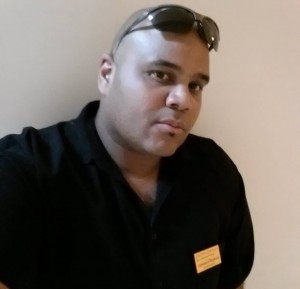Life sends a graduate student through a number of twists and turns in his professional career that he now uses to shape his adventure at Iowa State.

When he was five years old, Cameron Rayburn took an IQ test that placed him in the genius level. His gifts would later manifest in high school where he excelled at math and science.
He took a career assessment test during his sophomore year that showed he liked solving complex problems – the makings of an engineer. It even recommended aerospace engineering as a potential career path.
However, it also said he didn’t like people.
“I thought that was kind of strange since engineers work in teams and with people all the time,” Rayburn, now a gradate research assistant and academic advisor of aerospace engineering, mused.
He researched the field and decided that aerospace engineering was indeed a perfect fit. After graduating from high school at 16 years old, he set out for Tuskegee University, Alabama, to study the discipline.
At the time, Iowa State University had also tried to recruit him. He politely declined but didn’t forget the offer. “I always said that if I ever think about graduate school, I’ll consider Iowa State,” he explained.
Rayburn graduated from Tuskegee with a bachelor’s in aerospace engineering in 2001. Officially an aerospace engineer, he says he was ready to design next-generation space exploration technology.
But life had other plans that would eventually invoke within him a passion for helping others learn.
He experienced difficulty finding a job in aerospace engineering, so he moved to Illinois where his family was located and became a counselor at the Family Centered Educational Center in the Chicago area. He used his engineering background to tutor at-risk students in math and science for the center’s college preparation program – Upward Bound.
After a few years at the center, Rayburn found another opportunity to help others learn. This time, it was in an academic environment. He became an adjunct professor at South Suburban College and Prairie State College in Illinois where he taught math classes. It was after his first semester of teaching that he began to see his life’s calling.
“I never thought I’d be interested in teaching, but I learned to enjoy it after seeing the impact it had on my students,” he said.
A few years later, the colleges’ curriculum changed, and Rayburn was no longer qualified to teach his math classes. He found a job nearby at Applied Systems where he worked as a software analyst developing computer programs. He also began to consider graduate school and remembered his earlier decision to consider Iowa State for a master’s degree program.
Rayburn sent the university his information and was invited for a tour of the facilities. He was instantly hooked, and it wasn’t long before he packed his bags for Iowa.
He moved into his current advising position after helping teach the freshman-level course – Aerospace Engineering 160 – as a teaching assistant. His experience in counseling and teaching made him a prime candidate for the job.
When classes are in session, his office in Howe Hall is almost always busy.
“Usually there are at least two or three students here just hanging out,” he said. “A lot of times, they come in and decompress when they’re stressed out. I try to foster a safe and trusting environment.”
In addition to his advising responsibilities, Rayburn is working on his graduate research project this summer.
Using Iowa State’s wind tunnel, a team of aerospace engineering students – including Rayburn – is conducting a study that could potentially develop high-lift aircraft wings. Achieving greater lift allows an airplane to take off faster and increases fuel efficiency, he says.
The team uses actuators – devices that create short bursts of air – to reattach the airflow over the airfoil of a model airplane wing, which they use in measuring pressure distributions across the airfoil. This data is used to create models that predict the drag and lift of a wing.
“When an airfoil (wing) travels through the air, there is air that travels or flows along the surface of the wing,” he explained. “If the air gets ‘detached’ from the surface, you lose some of your lift force. Keeping the air ‘attached’ to the wing as long as possible will reduce drag and increase your lift.”
Rayburn aims to finish his master’s degree before the end of 2014. Wherever life takes him, he says it will most likely involve students and teaching.